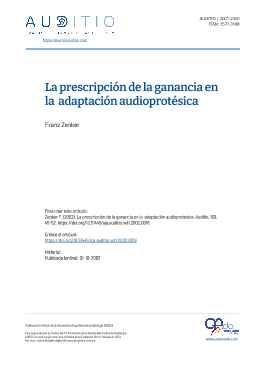Gain prescription for hearing-aid fitting
DOI:
https://doi.org/10.51445/sja.auditio.vol1.2002.0018Keywords:
hearing aids, hearing-aid fitting, gain prescription, NAL, DSL, IHAFF, POGO, FIG6Abstract
Hearing aids based on digital technology have fostered the emergence of new prescription formulas for gain. There are currently two large groups of formulas: generic ones, applicable to any type of hearing aid, such as DSL or NAL-R, and specific formulas developed by manufacturers for specific models and brands of hearing aids, such as ASAII from Oticon or Phonak DIGITAL. Both groups of formulas have advantages and limitations. Specific formulas are fast and do not require great knowledge. Generic formulas, on the other hand, allow the differentiating aspects of each individual to be considered in a broad way in the final prescription of profit. In this article we review the main generic prescription prescription methods that have appeared in recent years.
Downloads
Visibility and Altmetrics
Metrics
Global Statistics ℹ️
|
3741
Views
|
7544
Downloads
|
|
11285
Total
|
|
References
Carhart R. (1946). Tests for selection of hearing aids. Laryngoscope. 56:780-94. https://doi.org/10.1288/00005537-194612000-00004
Watson y Knudsen V. (1940). Selective amplification in hearing aids. J Acoust Soc of Am. 18:401-8.
Lybarger S. (1944). Method of fitting hearing aids. U.S. Patent Applications S.N. 543,278.
Davis H, Hudgins C, Marquis R, et al. (1946). The selection of hearing aids. Laryngoscope. 56:85-163. https://doi.org/10.1288/00005537-194604000-00002
Teter D. (1989). Keynote address: Hearing aids and aural rehabilitation. Academy of Rehabilitation in Audiology, Summer Institute. Austin, TX.
Berger KW, Hagberg EN, Rane RL. (1988). Prescription of hearing aids: Rationale, Procedure and Results. 5th Edition, Herald Publishing, Kent OH.
Cornelisse LE, Seewald RC, Jamieson DG. (1995). The input output fórmula: A theoretical approach to the fitting of personal amplification devices. J Acoust Soc Am. 97:1854-64. https://doi.org/10.1121/1.412980
Hawkins D. (1992). Prescriptive approaches to selection of gain and frequency response, In: Mueller HG, Hawkins DB, Northern JL, editors. Probe tube microphone measurements: hearing aid selection and assessment. San Diego, CA: Singular Publishing.
Byrne D. (1993). Hearing aid gain and frequency response selection strategies. In: Studebaker GA, Hochberg I, editors. Acoustic factors affecting hearing aid performance. Boston: Allyn and Bacon.
McCandless G. (1994). Hearing aid fórmulae and their application, In: Sandlin R, editor. Hearing aid handbook: volume I theoretical and technical considerations. San Diego, CA: College-Hill Press.
Kießling J. Hearing aid fitting and verification strategies , OtoAcademy, CRS Amplifon.com (citado 1 de agosto de 2001). Unavailable resource, closest similariy: https://doi.org/10.1080/010503901300007074
McCandless G. y Lyregaard P. (1983). Prescription of gain and output (POGO) for hearing aids. Hear Instr. 34:16-21.
Byrne D, Dillion H. (1986). The National Acoustic Laboratories (NAL) new procedure for selecting the gain and frequency response of a hearing aid. Ear Hear. 7:257-65. https://doi.org/10.1097/00003446-198608000-00007
Killion M. y Fikret-Pasa. (1993). The three types of sensorineural hearing loss: loudness and intelligibility consideration. Hear J.46:31-6.
Seewald RC. (1995). The Desired Sensation Level (DSL) method for hearing aid fitting in infants and children. Phonak Focus Nr. 20.
Dillon H, Katsch R, Byrne D, Ching T, Keidser G, Brewer S. (1998). The NAL-NL1 prescription procedure for non-linear hearing aids. NAL Annual Report 1997/98, 4-8. https://doi.org/10.1097/00025572-199904000-00002
Allen JB, Hall JL, Jeng PS. (1990) Loudness growth in 1/2-octave bands (LGOB) - A procedure for the assessment of loudness. J Acoust Soc Am 88, 745-753. https://doi.org/10.1121/1.399778
Kießling J. (1997) Versorgung mit Hörgeräten. In: Kießling J, Kollmeier B, Diller G: Versorgung und Rehabilitation mit Hörgeräten. Thieme Verlag Stuttgart, 49-109.
Haubold J. (1996). Zukünftige Hörgeräteanpassung aus der Sicht der Hörgeräteakustik. 8. Multidisziplinäres Kolloquium der Geers-Stiftung, Band 11, 147-163.
Moore BCJ, Alcantara JI, Glasberg BR. (1998). Development and evaluation of a procedure for fitting multi-channel compression hearing aids. Br J Audiol 32 (1998) 177-195. https://doi.org/10.3109/03005364000000062
Pastoors AD, Gebhart TM, Kiessling J. (1999). A fitting strategy for digital hearing aids based on loudness and sound quality. Proceedings of 4th European Conference on Audiology, Scand Audiol Suppl. (in press).
Schum, D. (1996). Adaptive Speech Alignment: A new fitting rationale made possible by DSP. The Hearing Journal, 49:5, 25-30.
Ludvigsen C. y Topholm J. (1997). Fitting a wide dynamic range hearing instrument using real ear threshold data: a new strategy. Hear Rev: High Performance Solutions 2:37-39.
Byrne D. y Tonnisson W. (1976). Selecting gain of hearing aids for persons with sensorineural hearing impairments. Scand Audiol. 5:51-9. https://doi.org/10.3109/01050397609043095
Mueller HG. (1992). Individualizing the ordering of custom hearing aids, In: Mueller HG, Hawkins DB, Northern JL, editors. Probe-microphone measurements: hearing aid selection and assessment, San Diego, CA: Singular Publications.
Bryne D, Parkinson A, Newell P. (1990). Hearing aid gain and frequency response requirements for the severely/profoundly hearing impaired. Ear Hear 1990;11:40-9. https://doi.org/10.1097/00003446-199002000-00009
Byrne D, Parkinson A, Newell P. (1991) Modified hearing aid selection procedures for severe/profound hearing losses. In: Studebaker G, Bess F, Beck L, editors. The Vanderbilt hearing aid report II. Parton, MD: York Press; 1991. p. 295-300.
Schwartz D, Lyregaard P, Lundh P. (1988). Hearing aid selection for severe-to-profound hearing loss. Hear J. 41:13-7.
Mueller H.B. (1995). Prescriptive hearing aid fitting, current issues in amplification. St. Louis, MO: Washington University.
Delgado J. y Zenker F. (2002). El promedio del espectro del habla: Fundamentos y aplicaciones clínicas. Auditio: Revista electrónica de audiología. 1(3)41-44. https://doi.org/10.51445/sja.auditio.vol1.2002.0017
Zenker F. y Barajas J. (1999). Adaptación de audífonos en función del promedio del espectro de la palabra hablada. Estudio de un caso único. En: Logopedia escolar y clínica. Últimos avances en Evaluación e Intervención. Editor: José Domingo Martín Espino, Madrid, Editorial CEPE, pp. 329-336.
Pascoe, D.L. (1988). Clinical measurements of the auditory dynamic range and their relation to formulas for hearing aid gain. In J. Hensen (Ed.), Hearing aid fitting: Theoretical and practical views (pp. 129-152). Proceedings of the 13th Danavox Symposium, Copenhagen.
Van Vliet D. (1995). Determining contour loudness judgements. Hear Instr. 46(March):30.
Cox R. (1995). Using loudness data for hearing aid selection: the IHAFF approach. Hear J.48:2, 10, 39-44. https://doi.org/10.1097/00025572-199502000-00001
IHAFF. (1994). A comprehensive hearing aid fitting protocol, distributed at Jackson Hole Rendezvous. Jackson, WY.
Valente M. y Van Vliet D.(1997). The independent hearing aid fitting forum (IHAFF) protocol. Trends in Amplification, 2(1),6-35. https://doi.org/10.1177/108471389700200102
Cox R, Goff CM, Martin SE, McLoud LL. (1994). The contour test: normative data, Presented at the AAA Convention. Richmond, VA.
Killion M. (1994). FIG6. Jackson Hole Rendezvous. Jackson, WY.
Sullivan R. (1988). Probe tube microphone placement near the tympanic membrane. Hear Instr. 39:43-4, 60.
Byrne D, Dillon H, Ching T, Katsch R & Keidser G. (2001). NAL-NL1 procedure for fitting nonlinear hearing aids: Characteristics and comparisons with other fitting methods. Jour AAA, 12 (1): 37-51.
Rankovic CM. (1991). An application of the articulation index to hearing aid fitting. Journal of Speech and Hearing Research. 34:391-402. https://doi.org/10.1044/jshr.3402.391

Published
Versions
- 2021-09-15 (2)
- 2002-10-01 (1)
How to Cite
Issue
Section
License
Copyright (c) 2002 Auditio

This work is licensed under a Creative Commons Attribution 3.0 Unported License.
All articles will be published under the open Creative Commons Attribution (CC-BY) license. This license allows others to share and adapt the content, even for commercial purposes, as long as appropriate credit is given to the authors and the journal. By submitting their manuscript, authors retain copyright but grant the journal the right to make the first publication under this license.
More information about this license is available at: https://creativecommons.org/licenses/by/4.0/
Articles published between 2001 and 2020
The texts published in this journal in the section "AUDITIO 2001-2020" are subject - unless otherwise indicated - to a Creative Commons Attribution 3.0 Spain license. You can copy, distribute, communicate them publicly, make derivative works and commercial uses provided that you acknowledge the credits of the works (authorship, name of the journal, publishing institution) in the manner specified by the authors or by the journal. The full license can be consulted at http://creativecommons.org/licenses/by/3.0/es/deed.es.









